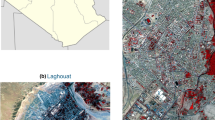Abstract
Width is one of the key parameters of a shelterbelt. Traditional methods to acquire this width are mainly based on field measurement, which is impractical for monitoring shelterbelts at regional scale. There are many studies analyzing linear objects, but they are not directly applicable to width detection of such objects. In this paper, we analyzed relationships among vegetation fractions retrieved from SPOT5 remote sensing imagery with 10 m × 10 m spatial resolution, shelterbelt area, and shelterbelt width in one pixel. Based on this analysis, we developed a method for recognizing shelterbelt width from a remote sensing image of central western Jilin Province, China. The result was validated by field measurement data and measurement from an aerial image of 0.5 m × 0.5 m spatial resolution. Mean absolute error was 2.40 and 2.73 m respectively, suggesting that the proposed method is feasible and its accuracy is acceptable. The study provides a valuable method for monitoring shelterbelt width across large spatial scales and an accurate input parameter for the recognition of shelterbelt porosity from remote sensing data in future research.















Similar content being viewed by others
References
Aksoy S, Akcay HG, Wassenaar T (2010) Automatic mapping of linear woody vegetation features in agricultural landscapes using very high resolution imagery. IEEE Trans Geosci Remote Sens 48(1):511–522
Brandle JR, Hodges L, Zhou XH (2004) Windbreaks in North American agricultural systems. Agrofor Syst 61:65–78
Carroll ZL, Bird SB, Emmett BA, Reynolds B, Sinclair FL (2004) Can tree shelterbelts on agricultural land reduce flood risk? Soil Use Manag 20(3):357–359
Deng RX, Li Y, Wang WJ, Zhang SW (2013a) Recognition of shelterbelt continuity using remote sensing and waveform recognition. Agrofor Syst 87:827–834
Deng RX, Wang WJ, Li Y, Zhao DB (2013b) A retrieval and validation method for shelterbelt vegetation fraction. J For Res 24(2):357–360
Ghimire K, Dulin MW, Atchison RL, Goodin DG, Hutchinson JMS (2014) Identification of windbreaks in Kansas using object-based image analysis, GIS techniques and field survey. Agrofor Syst 88:865–875
Gutman G, Ignatov G (1998) The derivation of the green vegetation fraction from NOAA/AVHRR data for use in numerical weather prediction models. Int J Remote Sens 19(8):1533–1543
Heisler GM, DeWalle DR (1988) Effects of windbreak structure on wind flow. Agric Ecosyst Environ 22(23):41–69
Hiroyuki T, Hajime S (2007) Relationship between shelterbelt structure and mean wind reduction. Agric For Meteorol 145:186–194
Martin ME, Newman SD, Aber JD, Congalton RG (1998) Determining forest species composition using high spectral resolution remote sensing data. Remote Sens Environ 65:249–254
Mayer H (1999) Automatic object extraction from aerial imagery—A survey focusing on buildings. Comput Vis Image Underst 74(2):138–149
Mulati Y, Norio T (2009) Effects of windbreak width in wind direction on wind velocity reduction. J For Res 20(3):199–204
Onana V, Trouve E, Mauris G, Rudant JP, Tonye E (2003) Linear features extraction in rain forest context from interferometric SAR images by fusion of coherence and amplitude information. IEEE Trans Geosci Remote Sens 41(11):2540–2556
Quackenbush LJ (2004) A review of techniques for extracting linear features from imagery. Photogramm Eng Remote Sens 70(12):1383–1392
Stange C (1996) Windbreak management. School of papers in natural resources, University of Nebraska, Lincoln
Tupin F, Maitre H, Mangin JF, Nicolas JM, Pechersky E (1998) Detection of linear features in SAR images: application to road network extraction. IEEE Trans Geosci Remote Sens 36(2):434–453
Tyndall J, Colletti J (2007) Mitigating swine odor with strategically designed shelterbelt systems: a review. Agrofor Syst 69(1):45–65
Wang X, Li Z, Liu X, Deng G, Jiang Z (2007) Estimating stem volume using QuickBird imagery and allometric relationships for open Populus xiaohei plantations. J Integr Plant Biol 49:1304–1312
Wiseman G, Kortb J, Walker D (2009) Quantification of shelterbelt characteristics using high-resolution imagery. Agric Ecosyst Environ 131:111–117
Zheng X, Zhu JJ, Yan Y (2013) Estimation of farmland shelterbelt area in the Three-North Shelter/Protective Forest Program regions of China based on multi-scale remote sensing data. Chin J Ecol 32(5):1355–1363
Acknowledgments
This work was supported by the National Natural Science Foundation of China under grant number 31400612, the Key Technologies Research and Development Program of Henan Province under Grant Number 142102110147, and the Key Carbon Program of the Chinese Academy of Sciences under Grant Number XDA05060400.
Author information
Authors and Affiliations
Corresponding author
Electronic supplementary material
Below is the link to the electronic supplementary material.
Rights and permissions
About this article
Cite this article
Deng, R.X., Li, Y., Xu, X.L. et al. Remote estimation of shelterbelt width from SPOT5 imagery. Agroforest Syst 91, 161–172 (2017). https://doi.org/10.1007/s10457-016-9915-1
Received:
Accepted:
Published:
Issue Date:
DOI: https://doi.org/10.1007/s10457-016-9915-1




